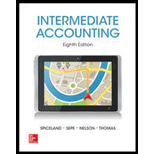
a)
IFRS: International Financial Reporting Standard is abbreviated as IFRS. The IFRS is set up to bring a standard global language in accounting, so that the other firms across the globe can understand the accounting term of all other businesses.
Investment: The act of allocating money to buy a monetary asset, in order to generate wealth in the future is referred to as investment.
Held-to-maturity security: The debt securities which are held by the investor with the intent to hold the investment till its maturity are referred to as held-to-maturity securities.
Available-for-sale (AFS) securities: These are short-term or long-term investments in debt and equity securities with an intention of holding the investment for some strategic purposes like meeting liquidity needs, or manage interest risk.
Other-than-temporary (OTT) impairment: When the market value of an investment declines to a value lower than its cost, it is referred to as OTT impairment. The OTT impairment is considered as permanent loss and the loss is recorded as decrease in net income or earnings.
Unrealized holding gains and losses: These are gains and losses which are unrealized and are the result of changes in cost and fair values of the investment for the period the investment is held.
Debit and credit rules:
- Debit an increase in asset account, increase in expense account, decrease in liability account, and decrease in
stockholders’ equity accounts. - Credit decrease in asset account, increase in revenue account, increase in liability account, and increase in stockholders’ equity accounts.
To Journalize: The investment made by Company F, in Company J assuming it to be held-to-maturity securities, as on December 31, 2016.
b)
To Journalize: The investment made by Company F, in Company J assuming it to be held-to-maturity securities, as on December 31, 2017.
c)
To Journalize: The investment made by Company F, in Company J assuming it to be available for sale securities, as on December 31, 2016.
d)
To Journalize: The investment made by Company F, in Company J assuming it to be held-to-maturity securities, as on December 31, 2017.
e)
To Journalize: The investment made by Company F, in Company J assuming it to be equity investment rather than debt investment, as on December 31, 2017.
Want to see the full answer?
Check out a sample textbook solution
Chapter 12 Solutions
INTERMEDIATE ACCOUNTING
- What is the dollar amount of taxes paid? Financial accountingarrow_forwardOrganic Harvest Inc. sells 40-pound bags of apples to grocery stores for $12 per bag. The fixed costs of the operation are $84,000, and the variable cost of apples is $0.15 per pound. What is the break-even point in bags? a) 5,600 bags b) 7,000 bags c) 8,400 bags d) 10,200 bagsarrow_forwardPlease given correct answer for General accounting question I need step by step explanationarrow_forward

 AccountingAccountingISBN:9781337272094Author:WARREN, Carl S., Reeve, James M., Duchac, Jonathan E.Publisher:Cengage Learning,
AccountingAccountingISBN:9781337272094Author:WARREN, Carl S., Reeve, James M., Duchac, Jonathan E.Publisher:Cengage Learning, Accounting Information SystemsAccountingISBN:9781337619202Author:Hall, James A.Publisher:Cengage Learning,
Accounting Information SystemsAccountingISBN:9781337619202Author:Hall, James A.Publisher:Cengage Learning, Horngren's Cost Accounting: A Managerial Emphasis...AccountingISBN:9780134475585Author:Srikant M. Datar, Madhav V. RajanPublisher:PEARSON
Horngren's Cost Accounting: A Managerial Emphasis...AccountingISBN:9780134475585Author:Srikant M. Datar, Madhav V. RajanPublisher:PEARSON Intermediate AccountingAccountingISBN:9781259722660Author:J. David Spiceland, Mark W. Nelson, Wayne M ThomasPublisher:McGraw-Hill Education
Intermediate AccountingAccountingISBN:9781259722660Author:J. David Spiceland, Mark W. Nelson, Wayne M ThomasPublisher:McGraw-Hill Education Financial and Managerial AccountingAccountingISBN:9781259726705Author:John J Wild, Ken W. Shaw, Barbara Chiappetta Fundamental Accounting PrinciplesPublisher:McGraw-Hill Education
Financial and Managerial AccountingAccountingISBN:9781259726705Author:John J Wild, Ken W. Shaw, Barbara Chiappetta Fundamental Accounting PrinciplesPublisher:McGraw-Hill Education





